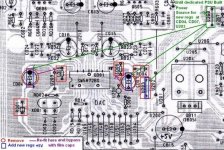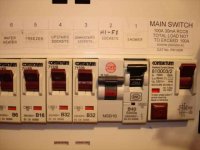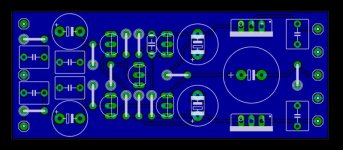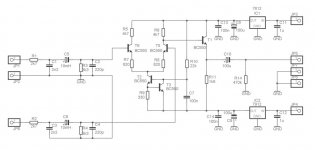Cheers Simon,
I think I must be a bit thick when it come sot this sort of thing (wrong kind of Engineer). I also missed the "not" in
"Big caps before regs have never not been recommended by anyone to my knowledge."
So what you and Brent say tallies and I'm happy with that.
k.
I think I must be a bit thick when it come sot this sort of thing (wrong kind of Engineer). I also missed the "not" in
"Big caps before regs have never not been recommended by anyone to my knowledge."
So what you and Brent say tallies and I'm happy with that.
k.
Wife has soldered in most of the parts in rays 67SE list, we just have to solder together some "Raygulators" and I'm waiting on the PCB for a PFM Flea for a clock. Might use another one for +5V reg too, (Martin Clark said no good for +/-12V though).
Can't wait to get it back together and test it out, might do that before the clock and the raygulators, then stick those in and see how it goes. Case damping and wooden feet too. Just takes a while with 2 wee kids 2+3 yrs!
Replacing the 12V regs at Q801/Q802 seems fairly straight forward so next its onto 5V regs, which are less well documented as they are not "drop-in" replacements, correct? Is the attached arrangement for Digital/Clock/Analog parts of the DAC OK? I got it from Post #593, #995, #1963, #3825 and others, except I will use LM317/337 regs rather than LM340 regs.
I know from reading that I should eventually be "feeding" the seperate regs with a new psu (presume one PSU for all 3 is OK?) and I will also need to build a separate 18V (min.) PSU for the PFM Flea-based clock), but until then presume U268 is OK as a +ve take-off point for all 3 regs? Is the GND to U267 (the minus of C813) OK for the 5V regs (Ray noted this as a ground for a clock earlier) or should these regs go through to the ground plane?
If I feed the clock with a flea+ext. PSU, am I correct in saying I then no longer need (i.e. I then MUST remove) the 5V reg feeding the clock?
ta
k.
Can't wait to get it back together and test it out, might do that before the clock and the raygulators, then stick those in and see how it goes. Case damping and wooden feet too. Just takes a while with 2 wee kids 2+3 yrs!
Replacing the 12V regs at Q801/Q802 seems fairly straight forward so next its onto 5V regs, which are less well documented as they are not "drop-in" replacements, correct? Is the attached arrangement for Digital/Clock/Analog parts of the DAC OK? I got it from Post #593, #995, #1963, #3825 and others, except I will use LM317/337 regs rather than LM340 regs.
I know from reading that I should eventually be "feeding" the seperate regs with a new psu (presume one PSU for all 3 is OK?) and I will also need to build a separate 18V (min.) PSU for the PFM Flea-based clock), but until then presume U268 is OK as a +ve take-off point for all 3 regs? Is the GND to U267 (the minus of C813) OK for the 5V regs (Ray noted this as a ground for a clock earlier) or should these regs go through to the ground plane?
If I feed the clock with a flea+ext. PSU, am I correct in saying I then no longer need (i.e. I then MUST remove) the 5V reg feeding the clock?
ta
k.
Attachments
ian21 said:and in case i'm not the last person to add a radial circuit at the front of the busbar just for cdp most defi recommend it.
Ian
Excellent! I wish I could do it!!
ian21 said:Also ' slug barrier tape ' £5 from b&q 4 metres x 20mm self adhesive copper tape .. and it solders well .
Wow, that's the shielding tape we've been waiting for! Or was that suggestion to help keep animals out of my infested kitchen cupboard?
On my large chip I used a piece of unetched pcb. That's the chunky solution!
Simon
Now then girls, have any of you messed around with attenuating your cd output.
Well I have. The audio is more spacious with finer details.
The amp is at 12 oclock instead of 9 oclock for the same given volume.
You have more adjustability of the volume too.
Most modern cd players are 2v rms on the output and most amps are now 150mV on their input. Basically whats happening is distortion as the input of the amp overloads.
The ideal attenuation for 2V output on cdp and 150mV on amp is -14db ish.
I have mine at -13.5db. This is due to me using 0.1% tol res and they are bizzare values.
Fit it right before your RCA sockets
Here is the simple circuit ive spent hours testing (-14db)(tested @ 900mV on it input and 188mV on its output)
Brent
Well I have. The audio is more spacious with finer details.
The amp is at 12 oclock instead of 9 oclock for the same given volume.
You have more adjustability of the volume too.
Most modern cd players are 2v rms on the output and most amps are now 150mV on their input. Basically whats happening is distortion as the input of the amp overloads.
The ideal attenuation for 2V output on cdp and 150mV on amp is -14db ish.
I have mine at -13.5db. This is due to me using 0.1% tol res and they are bizzare values.
Fit it right before your RCA sockets
Here is the simple circuit ive spent hours testing (-14db)(tested @ 900mV on it input and 188mV on its output)
An externally hosted image should be here but it was not working when we last tested it.
Brent
IMHO attenuating the output is not the way to tackle a too sensitive preamp input. Like Andrew says, the higher output impedance is something to steer away from. Also there's extra components in the signal path that can be avoided. Furthermore S/N ratio will be worse; the signal through the interlink will be weaker, etc. etc...
It's better to cure the problem at the source, like lowering the amplification of the first opamp in the input stage for example. Or losing it completely. Nowadays a preamp with an input sensitivity of 150mV is a bit ridiculus in my opinion. Why do you need a preamp anyway (unless you are into vinyl of course)? A rotary switch and a volume pot is all it takes. All sources like the TV, CD-player and DVD player are about the same volume level.
Regards,
Ray
It's better to cure the problem at the source, like lowering the amplification of the first opamp in the input stage for example. Or losing it completely. Nowadays a preamp with an input sensitivity of 150mV is a bit ridiculus in my opinion. Why do you need a preamp anyway (unless you are into vinyl of course)? A rotary switch and a volume pot is all it takes. All sources like the TV, CD-player and DVD player are about the same volume level.
Regards,
Ray
Here's a preview of the discrete output stage PCB i'm working on at the moment. Don't mind the electrolytics in the passive filter, i'm too lazy to draw a shape for the inductors  . The idea is to put the regulators on the PCB too, and I hope I've left enough room around them for dedicated super-regs to fit in. The post-reg caps can be bypassed with a big 100n PPS if desired. There's room for a 100u Black Gate N output cap, any other bigger film cap is better to be fitted outside the PCB I think. The current-sink-with-two-diodes is replaced by a version with two transistors. Any comments?
. The idea is to put the regulators on the PCB too, and I hope I've left enough room around them for dedicated super-regs to fit in. The post-reg caps can be bypassed with a big 100n PPS if desired. There's room for a 100u Black Gate N output cap, any other bigger film cap is better to be fitted outside the PCB I think. The current-sink-with-two-diodes is replaced by a version with two transistors. Any comments?
Ray
Ray
Attachments
And here's the schematic. The filter part values are for the SA8400, but it can be used with the original 63/67 FET/transistor stage. T1, T5 and T6 can be transistors or FETs (2SK170), or a mixed version can be made. Be sure to read a darlington for T1 (BC517) as I was too lazy to look one up  . All will be sorted in the final version
. All will be sorted in the final version  .
.
Ray
 .
.Ray
Attachments
AndrewT said:Hi Rowe,
why did you choose a T attenuator?
It gives a higher source impedance seen by the amp.
A plain L attenuator using 1k & 270r will give Zout=213r
Will the cdp like feeding a near 1k load?
Or fit it inside the RCA plug that goes into the amp.
Using lower values (270ohm) loaded the cdp output. The mV out before the resistor was being dropped which I did'nt like.
Some people beleive very firmly in attenuating the cd output.
http://www.russandrews.com/category...000117406985FKNCYIFVMPVNUTHS&cat_id=PINTEANAL
click on 'How do I cure that hard ‘CD’ sound?' (on the right)
and then click 'For more detailed information click here'
Brent
6h5c said:Why do you need a preamp anyway (unless you are into vinyl of course)? A rotary switch and a volume pot is all it takes. All sources like the TV, CD-player and DVD player are about the same volume level.
Regards,
Ray
Hi Ray,
Do you like that limp, lifeless sound? I prefer the sound with a preamp. Gutsy, with bass. I lived a while with the CDP straight into the power amp and it was not good enough.
IMHO
Simon
any good cdp trouble shooters out there?
Hi Guys
Ive got issues, any one got some ideas.
I posted here.
http://www.diyaudio.com/forums/showthread.php?postid=1067287#post1067287
Is a skipping cd player just a faulty laser? Im sure it was ok before I did my mods and everything hs been checked again. It seems to go fine somedays and bad others.
help much appreciated. Want to sort this play out so I can get onto finishing my cd67se
Hi Guys
Ive got issues, any one got some ideas.
I posted here.
http://www.diyaudio.com/forums/showthread.php?postid=1067287#post1067287
Is a skipping cd player just a faulty laser? Im sure it was ok before I did my mods and everything hs been checked again. It seems to go fine somedays and bad others.
help much appreciated. Want to sort this play out so I can get onto finishing my cd67se
SimontY said:
Hi Ray,
Do you like that limp, lifeless sound? I prefer the sound with a preamp. Gutsy, with bass. I lived a while with the CDP straight into the power amp and it was not good enough.
IMHO
Simon
Hi Simon,
Have you tried a TVC before ? It'll change your mind about active preamps forever....
cheers..
Hi Rowe,
you can attenuate your CDP if that gives improved sound. I have no problem with that. Or even if it improves operation (matched signal levels).
I asked two questions.
Why "T" when it increases the source resistance seen by the receiver?
Can CDP drive a near 1k load?
Are you sure you have the correct/best attenuator here?
Why on earth refer me to Russ Andrews' site selling attenuators for £90 a pair, when you can make one with two resistors costing £0.015 and fit them inside an existing RCA plug?
you can attenuate your CDP if that gives improved sound. I have no problem with that. Or even if it improves operation (matched signal levels).
I asked two questions.
Why "T" when it increases the source resistance seen by the receiver?
Can CDP drive a near 1k load?
Are you sure you have the correct/best attenuator here?
Why on earth refer me to Russ Andrews' site selling attenuators for £90 a pair, when you can make one with two resistors costing £0.015 and fit them inside an existing RCA plug?
Simon, this sounds more like a better matched set of input/output impedances rather than better with a preamp.SimontY said:I prefer the sound with a preamp. Gutsy, with bass. I lived a while with the CDP straight into the power amp and it was not good enough.
Passive attenuator is difficult to get performing well if the source and receive impedances are dancing all over as you adjust volume. But, it is possible with certain combinations.
Adding buffers before and/or after the volume help tremendously at correcting the required impedances.
The pre-amp if designed correctly is basically a buffered volume control and a switch. It's the correction provided by the buffer that gets rid of the problem impedance that sounds better. Not the pre-amp per se.
Will,
what's a TVC?
AndrewT said:Hi Rowe,
you can attenuate your CDP if that gives improved sound. I have no problem with that. Or even if it improves operation (matched signal levels).
I asked two questions.
Why "T" when it increases the source resistance seen by the receiver?
Can CDP drive a near 1k load?
Are you sure you have the correct/best attenuator here?
Why on earth refer me to Russ Andrews' site selling attenuators for £90 a pair, when you can make one with two resistors costing £0.015 and fit them inside an existing RCA plug?
I went with the 'T' circuit after plenty of research, there is conflicting ideas on which is best but there seemed to be more favour towards the 'T' over the 'L'. Some amp inputs did not like the resistor to gnd.
I sent the link to Russ A so you and people could see the reason for doing this. NOT to buy one. And why can't he make one with cheap plugs as he charges a small amount to buy an interconnect with the attenuation option fitted!
Maybe 1K could be a little large a value, this is for me to experiment with.
Brent
- Home
- Source & Line
- Digital Source
- Marantz CD63 & CD67 mods list



